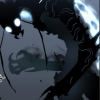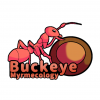At first I thought they were formica. Because of the big eyes.
But looking at my "new england ant guide" lasius seems more likely. Here is a size comparison with Lasius neoniger. I've used red lines to show the body length of each queen. She's a big girl for a lasius...
Formica and Lasius have the issue of sounding very similar on paper, despite not being closely related. These ones are definitely Formica.
What species is this? It's not Formica subsericea... she looks nothing like that queen...
What features don't seem like F. subsericea to you? I'm actually 99% sure it is F. subsericea. The workers have rounded heads, long antennal scapes, and are largely lacking erect hairs. The only identifying feature I can't make out very well are the hairs on the gaster (F. subsericea would have a decent number of hairs on the gaster and very few or no hairs anywhere else). I only hold off from giving a completely confident ID since these are nanitics and their features might not completely match up with full size workers. But I still believe enough features match, even as nanitics, to safely call these F. subsericea.
I thought fusca was only in europe
The species Formica fusca is, but the fusca group is much more broadly distributed. The fusca group is a taxonomic mess right now, but until it gets fixed up, species like this one are considered to be part of the fusca group.
https://antwiki.org/...es_groups#fusca
Edited by Mettcollsuss, April 5 2022 - 5:15 AM.
























